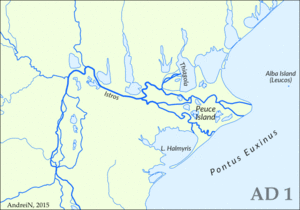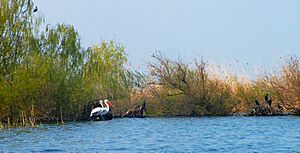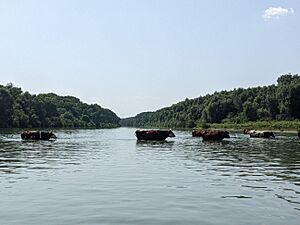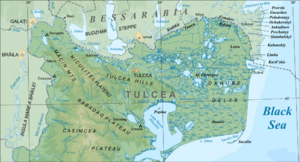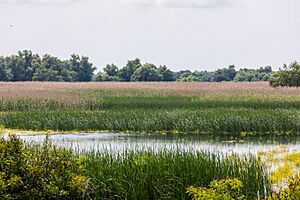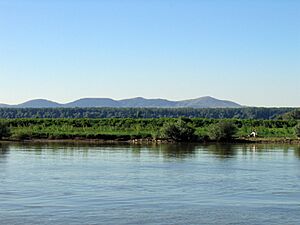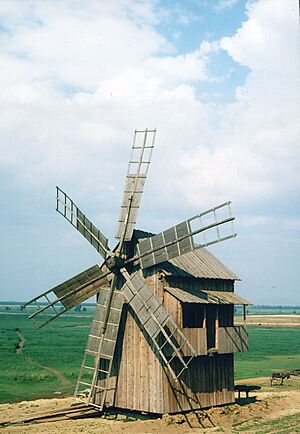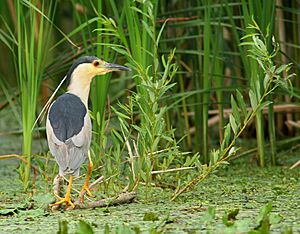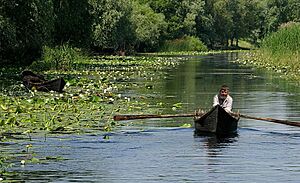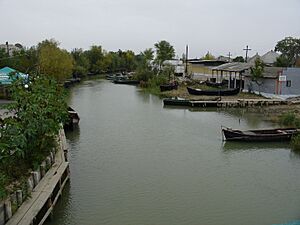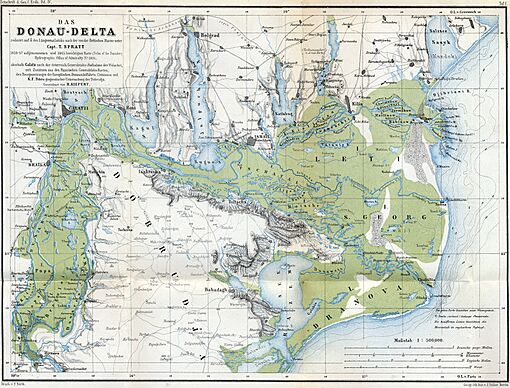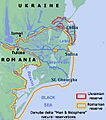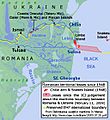Danube Delta facts for kids
| UNESCO World Heritage Site | |
|---|---|
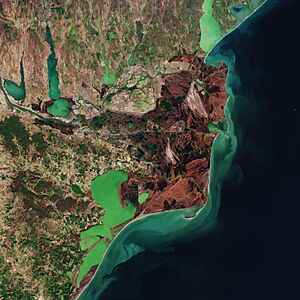 |
|
| Location | Tulcea County, Romania and Odesa Oblast, Ukraine |
| Criteria | Natural: vii, x |
| Inscription | 1991 (15th Session) |
| Area | 312,440 ha |
| Designated: | 21 May 1991 |
| Reference #: | 521 |
The Danube Delta (Romanian: Delta Dunării Ukrainian: Дельта Дунаю, romanized: Del'ta Dunaju) is a huge river delta in Europe. It's the second largest after the Volga Delta and the best preserved on our continent. This amazing place is where the Danube River flows into the Black Sea.
Most of the Danube Delta is in Romania (Tulcea County). A smaller part is in Ukraine (Odesa Oblast). The delta covers about 4,152 square kilometers. About 3,446 square kilometers are in Romania. If you add the nearby Razim–Sinoe lagoons, the total area is about 5,165 square kilometers. The Razim–Sinoe lagoons are connected to the delta. Because of its special nature, the whole area is a World Heritage Site.
Contents
Geography of the Danube Delta
The Danube Delta started forming around 4000 BC. This happened when the Black Sea's water level rose. A sand barrier first blocked the Danube's bay. Over time, the river filled the bay with sediment (tiny bits of dirt and rock).
After 3500 BC, the delta grew beyond this barrier. It formed several new parts called lobes. These include the St. George I (3500–1600 BC), Sulina (1600–0 BC), St. George II (0 BC–present), and Chilia (1600 AD–present). Other smaller lobes formed in lakes and lagoons nearby.
Much of the delta's growth came from soil erosion. This happened when people cleared forests in the Danube basin long ago. A geologist named Liviu Giosan said that about 40% of the delta formed in the last 1000 years.
Today, the delta gets less sediment. This is because many dams were built on the Danube River. However, many small channels were also built in the delta. These channels help to spread the sediment. This has helped to reduce erosion along the coast.
The Danube Delta is a flat, low area. It is mostly covered by wetlands and water. It has many marshes, channels, small streams, and lakes. The average height is only 0.52 meters above sea level. About 20% of the delta is actually below sea level. More than half is less than one meter high. Some sand dunes are higher, like those on Letea (12.4 m) and Caraorman (7 m). The biggest lakes are Dranov (21.7 km²), Roșu (14.5 km²), and Gorgova (13.8 km²).
Main River Branches
The Danube River splits into three main branches as it enters the delta. These are the Chilia, Sulina, and Sfântul Gheorghe (Saint George). The Sulina and Sfântul Gheorghe branches first form the Tulcea channel. This channel flows as one for several kilometers before splitting. New land slowly forms at the mouth of each branch. This means the delta is still growing!
| Danube arm | Length (km) | Average Flow (m³/s) |
|---|---|---|
| Chilia | 120 | 3800 |
| Sulina | 64 | 1250 |
| Sfântu Gheorghe
(Saint George) |
70 | 1500 |
The Chilia is in the north. It is the longest, newest, and most active branch. It has two smaller deltas forming inside it. One tiny delta is still growing at its mouth towards Ukraine.
The Sulina is the middle branch. It is the shortest, so it has been used a lot for boat traffic. This has changed it quite a bit. The main port and only town in the Romanian delta are at its mouth. To help boats, a channel was built into the sea. This channel is now 10 km long.
The Sfântul Gheorghe (Saint George) is in the south. It is the oldest and has the fewest people living near it. The sediment it carries has created the Sacalin Islands. These islands started forming in 1897 and are now 19 km long.
Climate
The Danube Delta is one of Romania's sunniest and driest areas. The average yearly temperature is 11°C. It's about -1°C in January and 22°C in July. The delta gets between 300 and 400 mm of rain each year.
Main Ecosystems
The Danube Delta is part of the Pannonian steppe ecosystem. It also has some Mediterranean influences. Because it is a new and still-forming area, the delta is perfect for many different plants and animals. It has 23 natural ecosystems. Most of the delta is a watery environment because of all the wetlands. There are also dry land areas on higher ground. Here, plants that like dry conditions (called xerophiles) grow.
Between the water and land, there is a swampy area. This area floods easily. It has special plants and animals that can live in both wet and dry conditions. This depends on the season or how much water is around (the hydrological regime). Where fresh river water meets salty sea water, unique things happen. Biologists call this special area the beforedelta. Musura Gulf and Saint George Gulf are good examples of this ecosystem.
The Danube Delta is a very important place for birds. It is on major bird migration routes. It also has great places for birds to nest and hatch their young. Birds from six major areas of the world, including the Arctic, come here. Over 320 bird species are found in the delta during summer. About 166 species hatch their young here, and 159 are migratory. More than a million birds, like swans and ducks, spend the winter here.
Running Water Ecosystems
This ecosystem includes the main branches of the Danube. It also has many important smaller streams and channels. This environment is full of tiny living things (plankton), worms, and fish. You can find many types of fish here, such as carp, pike, pike perch, sheat-fish, and freshwater sturgeons.
Stagnant Water Ecosystems
This ecosystem includes the delta's lakes, ponds, and slow-moving channels. It has many floating and underwater plants. Some plants float on the surface, like the white water lily (Nymphaea alba). Others grow underwater, like Myriophyllum.
Many fish live in these waters. Important fish species include Tench (Tinca tinca), common bream (Abramis brama), common rudd (Scardinius erythropthalmus), and northern pike (Esox lucius).
Marsh and Flooding Areas Ecosystems

Reed plants and floating reed islands are very common in the Danube Delta. These floating islands are called plaur in Romania. The plants in this ecosystem are mostly common reed (Phragmites communis). Near river banks, you can also find cattail (Typha latifolia) and sedge (Carex dioica). These plants are perfect places for fish to lay eggs and for birds to nest. The plaur are a mix of reed roots, grass, and soil. They usually float or are attached to the riverbed. Reeds often grow around lakes and ponds, slowly covering the water's surface.
This ecosystem is known for its many different birds. Some are very rare. Important birds include the tufted duck (Aythya fuligula), red-crested pochard (Netta rufina), mallard (Anas platyrhynchos), and greylag goose (Anser anser). You can also see the great white pelican (Pelecanus onocrotalus) and Dalmatian pelican (Pelecanus crispus). The common pheasant (Phasianus colchicus) is a newer bird to the delta.
Mammals found here include the Eurasian otter (Lutra lutra), European mink (Mustela lutreola), and wild boar (Sus scrofa). In winter, you might see the European hare (Lepus europaeus). The Caspian tiger once lived in this area but is now gone. Some newer animals like the raccoon dog (Nyctereutes procyonoides) and muskrat (Ondatra zibethica) have also made the delta their home.
River Bank and Levee Ecosystems
The solid land in the delta used to have many willow trees. Most of these were cut down and replaced with Canadian poplars. You can still find small groups of willow trees (like Salix alba) on river banks that are still natural. These are sometimes mixed with white poplar (Populus alba).
On the higher areas called levees (like Letea and Caraorman), there are mixed forests. These forests have oak trees (Quercus robur) and other trees. They also have shrubs and climbing plants (vines). Some vines, like Periploca graeca, can grow up to 25 meters tall! On the Letea levee, these unique forests grow in dips between sand dunes. These small groves are called hasmace. Animals in this region include the meadow viper (Vipera ursinii) and the Eurasian eagle owl (Bubo bubo).
People of the Delta
The Danube Delta is one of the least populated areas in Europe. On average, only about 2 people live per square kilometer. In the Romanian part, about 20,000 people live there. About 4,600 of them live in the port town of Sulina. The rest live in 27 villages. Only three of these villages had more than 500 people in 2002. The city of Tulcea, at the delta's edge, has 92,000 people. It is the main gateway to the delta.
Life in the delta can be hard and isolated. People often move away from the delta when they grow up. The people who live here come from many different parts of Romania. The total population has stayed about the same for the last century. In the 1890s, there were 12,000 people. Before World War II, there were 14,000.
About 80% of the people are Romanians, and 10% are Ukrainians. Other groups include Greeks, Turks, and Bulgarians. A special group in the delta are the Lipovans. They are descendants of Orthodox Christians who fled Russia in the 1700s to escape religious problems.
On the Ukrainian side of the delta, the town of Izmail has 85,000 people. Kiliya has 21,800 people. Vilkovo is the main center for the Lipovan community there, with 9,300 people.
History of the Delta
History tells us that the Dacians lived in the Danube Delta before the Romans took over. After that, the region changed hands many times. In the 1400s, the Danube Delta became part of the Ottoman Empire.
Later, after wars, the borders changed. In 1812, the borders between the Ottoman and Russian Empires were set along the Kilia and Old Stambul Channels. In 1829, it moved to the St George Channel. The Treaty of Paris of 1856 ended the Crimean War. It gave the Danube Delta back to the Ottoman Empire. An international group was also created to help with navigation on the Danube River. In 1878, after another war, the border between Russia and Romania was set along the Kilia and Old Stambul Channels.
In 1991, the Romanian part of the Danube Delta became a UNESCO World Heritage Site. About 2,733 square kilometers of the delta are strictly protected.
In 1998, the entire Danube Delta, covering 6,264.03 square kilometers, became a biosphere reserve. This reserve is shared by Romania and Ukraine.
In Romania, part of the delta was first made a reserve in 1938. In Ukraine, a reserve was set up in 1973. It was later expanded into the Danube biosphere reserve in 1998.
Environmental Concerns
Big changes started in the Danube Delta in the mid-1800s. The Sulina branch was straightened starting in 1862. This work continued for many years. As a result, the Sulina branch became shorter (from 92 km to 64 km). Its water flow more than doubled. This made it easier for large ships to use. The Sfântu Gheorghe branch was also straightened. It became shorter (from 108 km to 70 km) and its flow increased.
These changes helped ships but harmed the delta's natural environment. Fish breeding patterns were disturbed. The faster water flow in the main branches caused more sediment to be carried away and banks to erode.
During the Communist era, reeds were harvested a lot. There were plans to turn the delta into a big farming and industrial area. While some farming started in 1939, large areas were drained for farming after 1960. By 1991, over 100,000 hectares of the delta were used for farming, tree farms, or fish farms. More than a third of the delta was affected.
These changes, along with more pollution in the Danube's waters, have hurt the fish population. Decades of overfishing and poor fishing rules have also reduced the number of fish.
In 2004, Ukraine started building the Bistroe Channel. This channel would create another way for ships to go from the Black Sea to the Ukrainian part of the delta. However, this new channel could harm the delta's delicate ecosystem. The European Union asked Ukraine to stop the work. Romanian officials even said they might take Ukraine to court. Ukraine argued that Romania was just worried about competition. Later, both countries agreed that experts should decide the channel's future. Ukraine still plans to build a shipping channel, even if it's not the Bistroe Channel.
Gallery
-
Areas changed for farming during the communist time
-
Reeds growing in the Danube Delta
See also
- Birds of the Danube Delta
- Danube Delta horse
- Danube–Black Sea Canal
- History of Dobruja
- List of World Heritage Sites in Romania
- Tourism in Romania
- Seven Natural Wonders of Romania
 In Spanish: Delta del Danubio para niños
In Spanish: Delta del Danubio para niños


